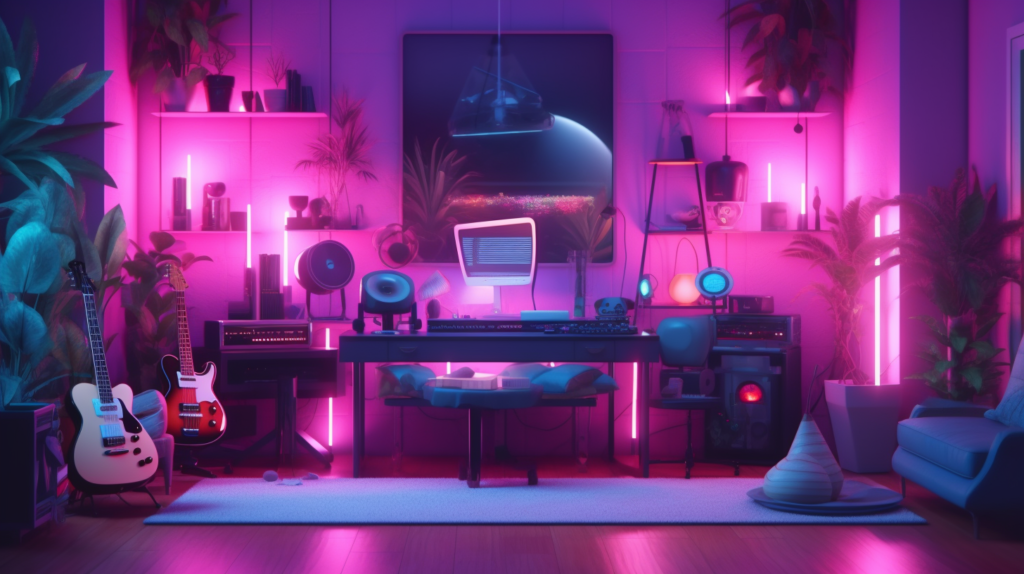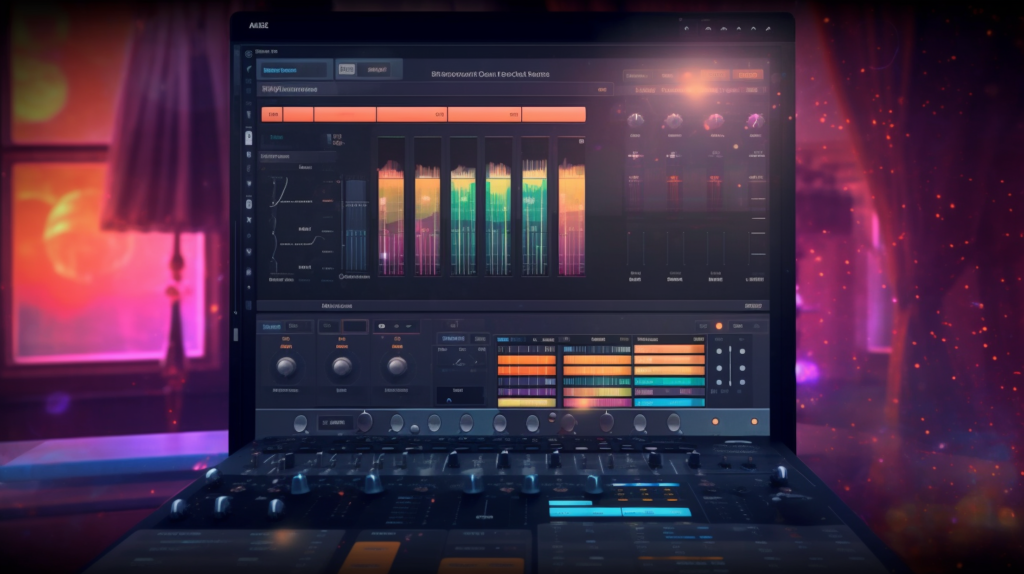
From the vintage warmth of analog synthesis to the crisp precision of the digital realm, synthesizers have unquestionably shaped the sonic landscape of modern music. The lush pads, growling basses, and piercing leads you hear in countless tracks owe their character to the humble synth. Our journey into the heart of music production begins here, with a keen eye on how synthesizers unlock a realm of sonic textures impossible to achieve otherwise. Let’s delve into the waveform wonderland and explore how you can harness the power of synthesizers to elevate your music production endeavors.
Historical Context
The emergence of synthesizers in the mid-20th century marked a bold stride into uncharted auditory territories. Suddenly, musicians had a palette of sounds at their fingertips that bore no allegiance to the physical world. The Moog and ARP, trailblazers of the synth realm, not only engineered sounds never heard before but propelled entire genres into new dimensions.
The 80s saw a surge of synth-pop and new wave genres, largely fueled by the accessibility and novel sounds of synthesizers. Fast forward to today, the legacy of those early innovations continues to reverberate across genres, from the pulsating rhythms of techno to the sonic explorations of ambient and beyond.
Understanding Synthesizers
At its core, a synthesizer is a sonic alchemist, morphing basic waveforms into complex sonic textures. The heartbeat of any synth lies in its oscillators, where the initial sound is generated. Typically, you’ll encounter waveforms like sine, sawtooth, square, and triangle, each with a distinct tonal flavor.
Venture next into the realm of filters. These are the sculptors of the synth world, carving out frequencies and adding resonance to shape the sound to your liking. The journey of sound doesn’t end here. The amplifiers and modulators step in to further mold the sonic material into a piece of art. They control the volume and dynamic movement of the sound, adding life and vigor to the static waveforms.
Now, how about types of synthesizers? The analog synth is your go-to for warm, organic sounds, while its digital counterpart offers precision and a vast array of sonic possibilities. Modular synthesizers provide a playground for the curious minds, and software synthesizers bring the synth world to your digital workstation, making music production an ever-evolving adventure.
Dive into the settings, tweak the knobs, and listen to how the sound transforms. The realm of synth techniques is vast, and the journey is as rewarding as the destination. Each twist and turn unveils a new shade of sound, waiting to be discovered and molded into your next musical masterpiece.
Integrating Synthesizers in Music Production
Stepping into the world of music production with a synthesizer by your side is akin to having a sonic Swiss army knife at your disposal. Right from the outset, setting up your synthesizer in your music production environment is a straightforward affair. Plug in, power up, and you’re ready to etch your sonic signature into your compositions.
Now, onto the grand narrative of MIDI (Musical Instrument Digital Interface) sequencing and control. MIDI is the language that allows your synthesizer, digital audio workstation, and other musical hardware to converse in harmony. It’s through MIDI that we breathe life into our synth sequences, laying down notes, tweaking parameters, and orchestrating dynamic changes over time.
Layering is where the magic truly happens. By layering different synthesizers, or even the same synth with varied settings, you can craft sonic textures of complex and satisfying richness. It’s akin to painting with a palette of auditory colors, each layer adding depth, contrast, and hue to the overall sonic picture.
Practical Techniques
The canvas of sound awaits, and with a synthesizer, you wield the brush to craft your auditory artwork. Let’s embark on the practical side of synth techniques, starting with sound design. Crafting leads, pads, basses, and rhythmic elements is a joyous venture into the heart of synthesis. Each category of sound demands a unique approach. For instance, a compelling bass sound often requires a robust low-end presence, achieved by utilizing sawtooth or square waveforms with a touch of filtering to tame the high frequencies.
Modulation is the spice of synth sound design. Applying modulation to parameters like pitch, filter cutoff, or amplitude adds dynamic movement and expression to your sounds. Explore the realms of LFOs (Low Frequency Oscillators) and envelopes to discover how they can animate your sounds in captivating ways.
Effects processing is another avenue to traverse. Reverb for space, delay for echoic rhythms, and distortion to add grit are just the tip of the iceberg. These effects, when applied thoughtfully, can elevate a simple synth sound to a complex, evocative sonic texture that resonates on a deeper level.
Genre-Specific Applications
Synthesizers are not bound by genre; they are bound by imagination. In electronic music, they are the bedrock, generating nearly every sound you hear. Pop music often leverages catchy synth leads and lush pads, while hip-hop embraces the raw, gritty textures that synths can deliver.
The iconic sounds of synthesizers have found a home in rock too. The haunting mellotron flutes of The Beatles’ “Strawberry Fields Forever” or the aggressive Minimoog bass in Rush’s “Tom Sawyer” showcase the genre-bending versatility of synthesizers.
Each genre extracts a unique flavor from the synthesizer, molding its versatile sonic offerings to serve the musical narrative. This versatility not only underscores the invaluable role of synthesizers in music production but also hints at the limitless creative potential awaiting your exploration.
Recommendations
Stepping into the realm of synthesizers can feel like venturing into a vast sonic forest. It’s a journey that begs for the right kind of gear to unlock the full spectrum of sonic textures available to you. From the warm, vintage tones of an analog synthesizer like the Moog Sub Phatty to the endless possibilities housed within a digital synthesizer like the Yamaha MODX, each piece of gear offers a unique pathway into the heart of synthesis.
For those whose pockets don’t run as deep, fret not. Budget-friendly options like the Arturia MicroBrute or the Korg Volca series provide a pocket of sonic wonder without breaking the bank. On the other end of the spectrum, high-end models like the Dave Smith Instruments Prophet 6 or the Moog One offer a premium voyage into the depths of synthesis.
Software synthesizers have democratized access to a plethora of sonic textures and synthesis techniques. The likes of Serum (free presets here !), Massive, or even the free synth plugin Helm, bring the power of synthesis right to your computer screen.
Future Trends
The horizon of synthesizers in music production is ever-expanding, with technological advancements like MIDI Polyphonic Expression (MPE) ushering in a new era of expressive potential. MPE allows for nuanced control over each note, enabling a more human, expressive interaction with synthesized sound.
As we venture further into the digital age, Virtual Reality (VR) and Augmented Reality (AR) are beginning to weave their threads into the fabric of music production. Imagine sculpting sonic textures in a three-dimensional VR environment or tweaking synth parameters in real-time with AR interfaces.
Community and Resources
The journey of mastering synthesizers is one best shared with fellow enthusiasts. Online forums like Gearspace or the subreddit r/synthesizers are bustling with discussions, advice, and shared experiences. These communities provide a haven for both novices and seasoned synthesists to exchange knowledge and fuel their passion for synthesis.
For a more structured learning path, myriad tutorials and courses are available online. Platforms like Skillshare or MasterClass offer courses that delve into the depths of synthesis and music production, providing a guided pathway to honing your synth skills.
Conclusion
Our venture into the world of synthesizers unveils a domain rich with sonic textures, technical intrigue, and boundless creative potential. Whether you’re a seasoned producer or a curious novice, the realm of synthesis holds a sonic treasure waiting to be unearthed. We’ve merely scratched the surface, and as the landscape of music production continues to evolve, so too will the role and capabilities of synthesizers.
Call to Action
Eager to share your synth-based projects or queries? The comment section below is a canvas for your thoughts. Engage with the Hit Producer Stash community and keep the conversation going. Stay tuned for more insights and tips to fuel your music production voyage.





